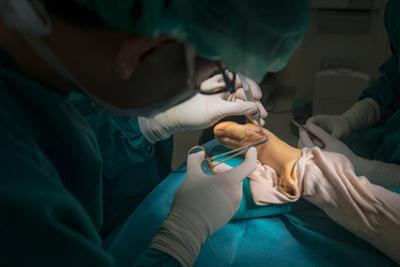Understanding Bunion Surgery: A Comprehensive Guide

- posted: Mar. 21, 2024
If conservative approaches aren’t providing relief from your bunions, Dr. Tod Reed at Cardinal Foot & Ankle in Muncie, IN, offers bunion surgery to get you back to your life.
Understanding Bunion Surgery
Bunions are bumps that form at the joint of the toe. They’re caused by a misalignment of the toe joint that leads to the bottom part of the toe sticking out to the side. Shoes then rub against the bump, making it more painful.
In some cases, conservative approaches provide relief. These approaches typically involve changing footwear or wearing splints to help keep the toe joint properly aligned. However, conservative approaches do not always provide the desired results, especially if the bunion is severe. In such cases, bunion surgery is recommended. Below, Dr. Reed and the team at Cardinal Foot & Ankle in Muncie, IN, explain this type of surgery and what to expect from it.
What Types of Bunion Surgeries Are Used?
There are more than 100 surgical techniques to address bunions. However, three are performed more often than others. One of these is called a bunionectomy. This is a technique in which the surgeon removes the bump and corrects the joint’s alignment.
An osteotomy is a surgical technique in which the bones are cut. Plates, pins, or screws are then used to straighten the toe’s alignment and improve its balance. In some cases, a small amount of the bone must be removed for full correction.
If bunions are severe or the patient suffers from arthritis, an arthrodesis is typically performed. This procedure involves removing the affected areas of the joint’s surface. Plates, wires, or screws are then placed to help the bones heal properly.
How to Prepare
Before your surgery ever takes place, you’ll have a pre-procedure consultation with the surgeon. The type of surgery being performed will be discussed so you’ll know what to expect. Additionally, you’ll be given guidelines for drinking and eating before the procedure. Be sure to disclose any medication you take so that you can be instructed in this area, as well.
Bunion procedures are typically outpatient, so you won’t need to worry about staying the night. It is important, however, that you have a ride home.
What to Expect from Recovery
You’ll need someone to help you out with errands and cooking for a few days, as you’ll need to stay off your foot. You’ll be given pain medication to help ease the discomfort. You should be able to fully return to all of your regular activities within three to four months.
Schedule a bunion surgery consultation with Dr. Reed at Cardinal Foot & Ankle in Muncie, IN, by calling (765) 287-8279.

- posted: Mar. 21, 2024
If conservative approaches aren’t providing relief from your bunions, Dr. Tod Reed at Cardinal Foot & Ankle in Muncie, IN, offers bunion surgery to get you back to your life.
Understanding Bunion Surgery
Bunions are bumps that form at the joint of the toe. They’re caused by a misalignment of the toe joint that leads to the bottom part of the toe sticking out to the side. Shoes then rub against the bump, making it more painful.
In some cases, conservative approaches provide relief. These approaches typically involve changing footwear or wearing splints to help keep the toe joint properly aligned. However, conservative approaches do not always provide the desired results, especially if the bunion is severe. In such cases, bunion surgery is recommended. Below, Dr. Reed and the team at Cardinal Foot & Ankle in Muncie, IN, explain this type of surgery and what to expect from it.
What Types of Bunion Surgeries Are Used?
There are more than 100 surgical techniques to address bunions. However, three are performed more often than others. One of these is called a bunionectomy. This is a technique in which the surgeon removes the bump and corrects the joint’s alignment.
An osteotomy is a surgical technique in which the bones are cut. Plates, pins, or screws are then used to straighten the toe’s alignment and improve its balance. In some cases, a small amount of the bone must be removed for full correction.
If bunions are severe or the patient suffers from arthritis, an arthrodesis is typically performed. This procedure involves removing the affected areas of the joint’s surface. Plates, wires, or screws are then placed to help the bones heal properly.
How to Prepare
Before your surgery ever takes place, you’ll have a pre-procedure consultation with the surgeon. The type of surgery being performed will be discussed so you’ll know what to expect. Additionally, you’ll be given guidelines for drinking and eating before the procedure. Be sure to disclose any medication you take so that you can be instructed in this area, as well.
Bunion procedures are typically outpatient, so you won’t need to worry about staying the night. It is important, however, that you have a ride home.
What to Expect from Recovery
You’ll need someone to help you out with errands and cooking for a few days, as you’ll need to stay off your foot. You’ll be given pain medication to help ease the discomfort. You should be able to fully return to all of your regular activities within three to four months.
Schedule a bunion surgery consultation with Dr. Reed at Cardinal Foot & Ankle in Muncie, IN, by calling (765) 287-8279.
Our Business Hours
Monday
8:00 am - 5:00 pm
Tuesday
8:00 am - 5:00 pm
Wednesday
8:00 am - 5:00 pm
Thursday
8:00 am - 5:00 pm
Friday
8:00 am - 12:00 pm
Saturday
Closed
Sunday
Closed
